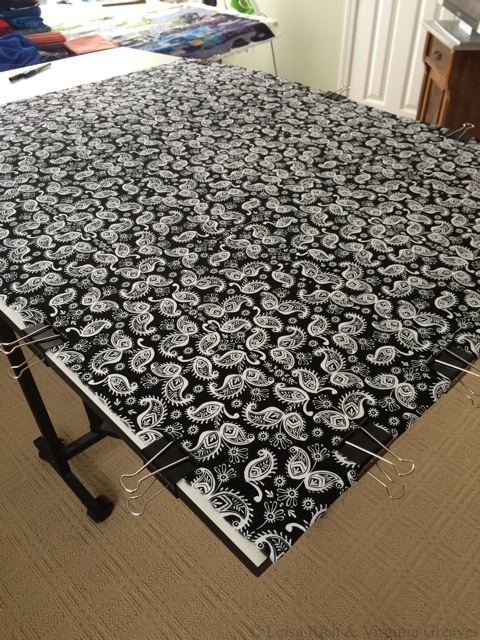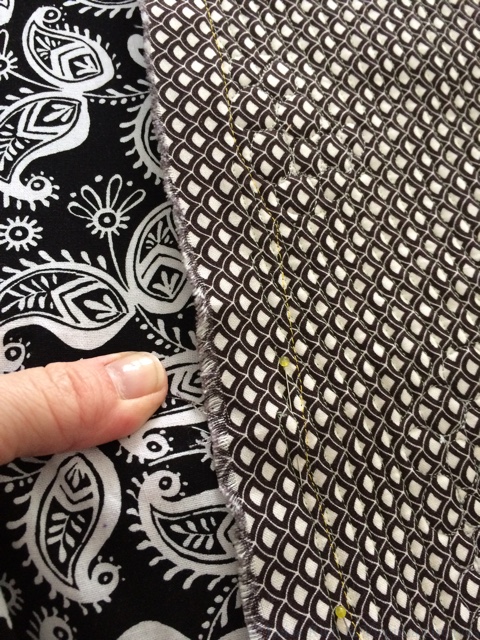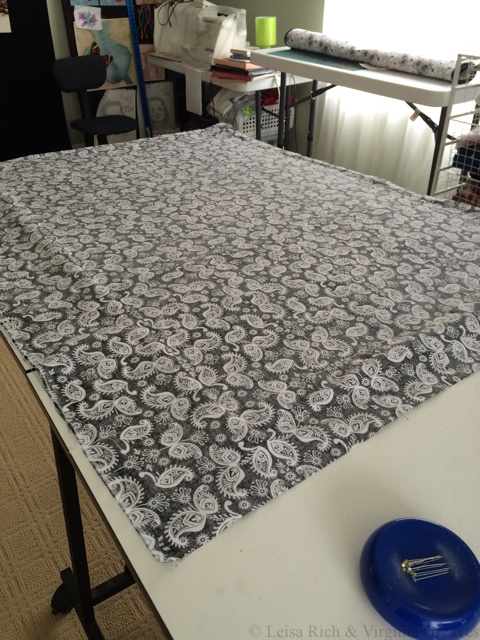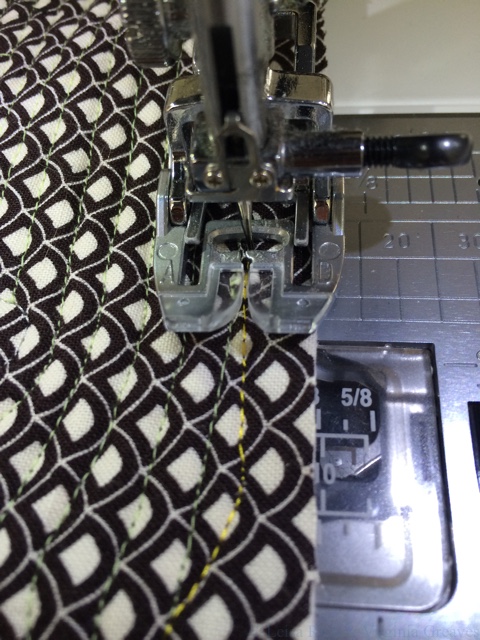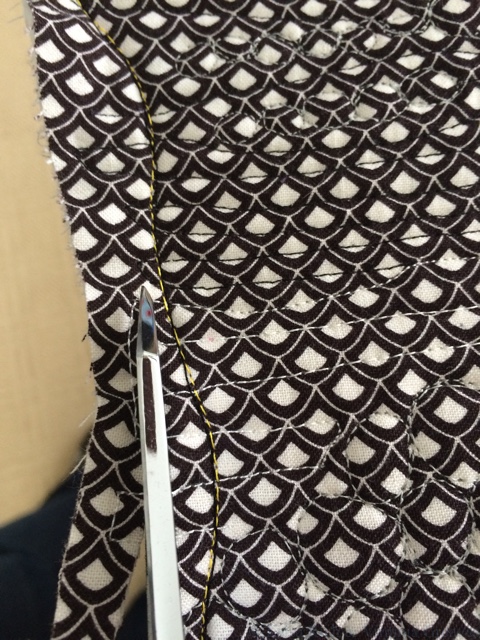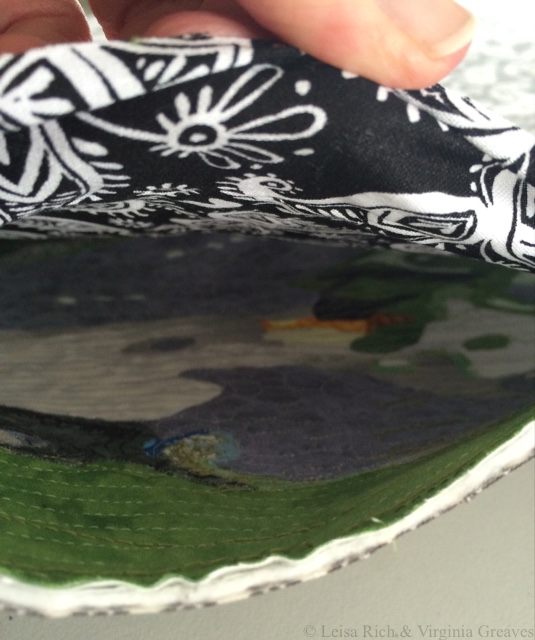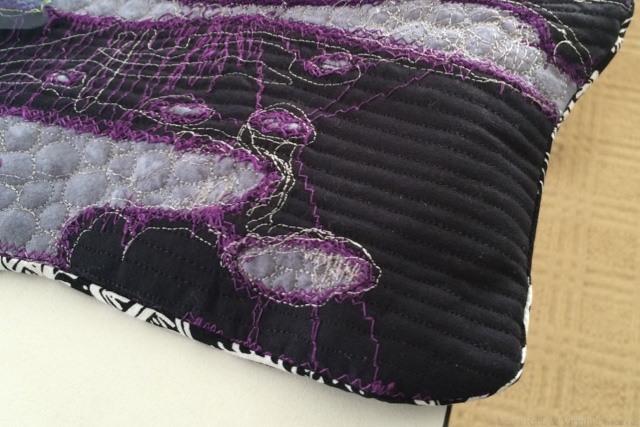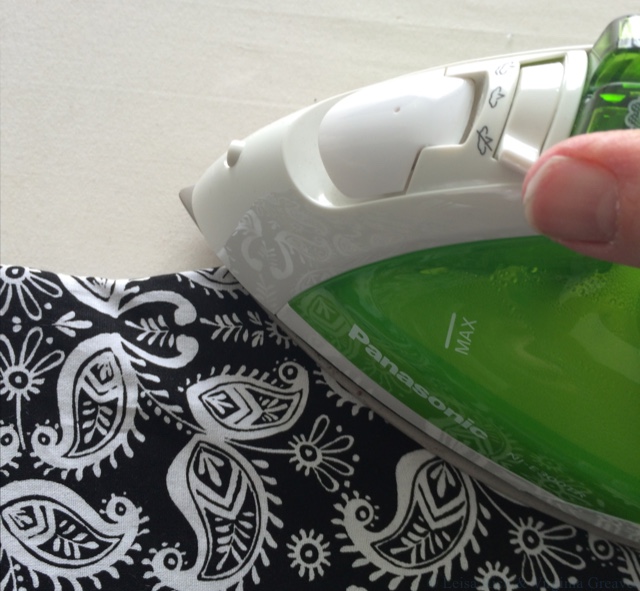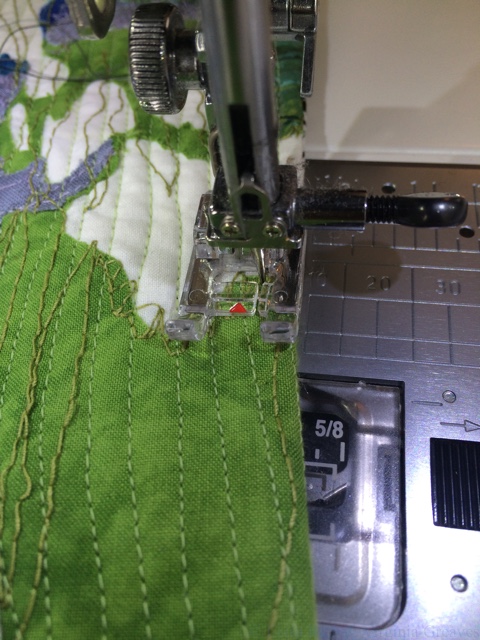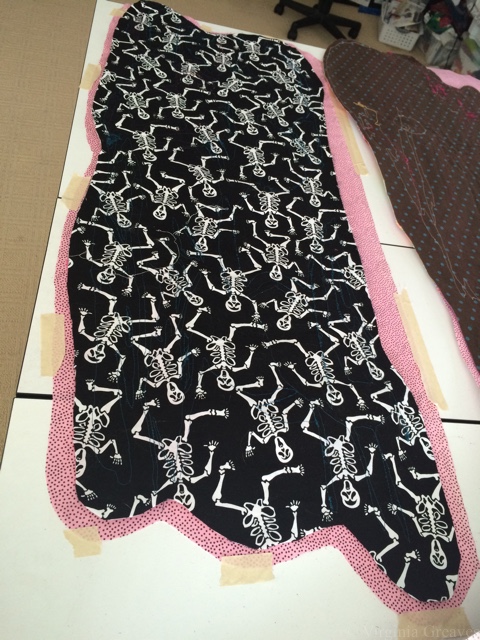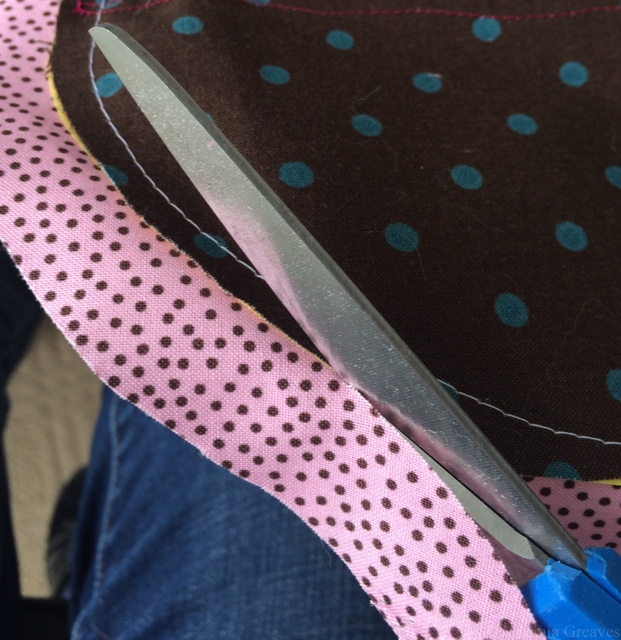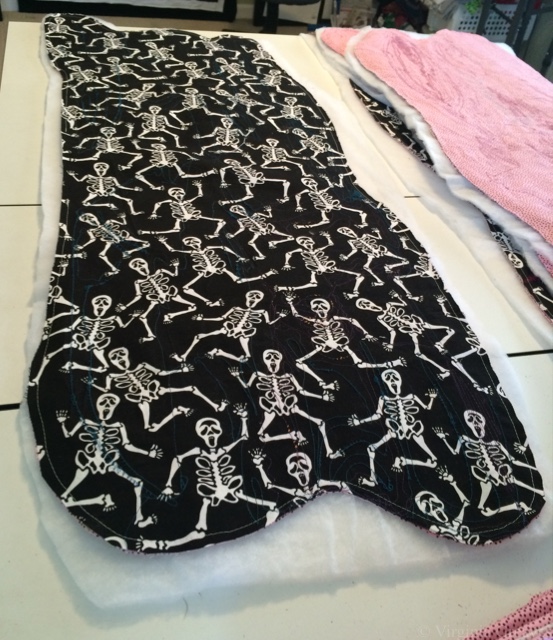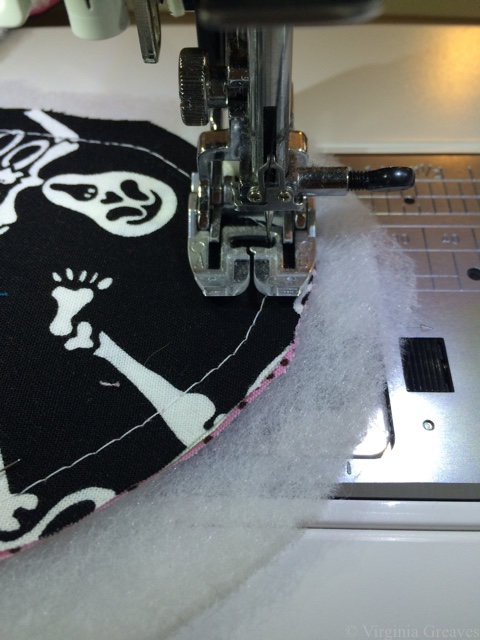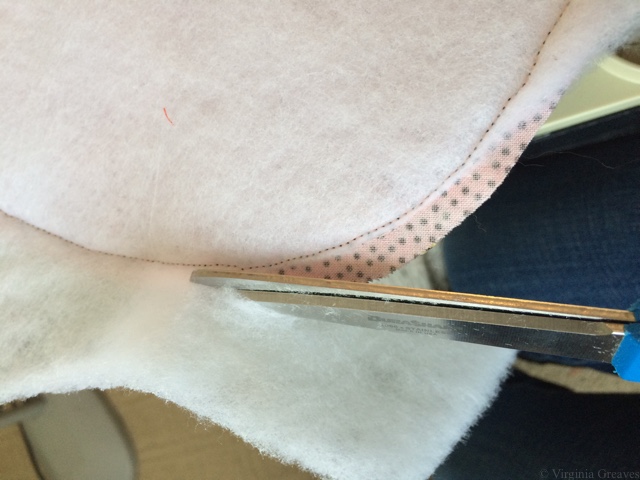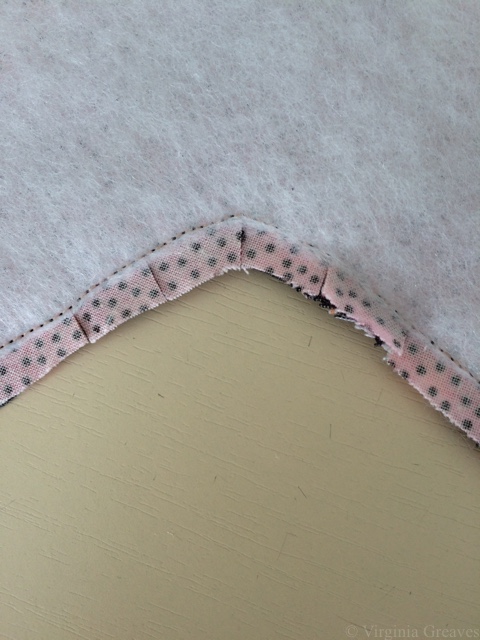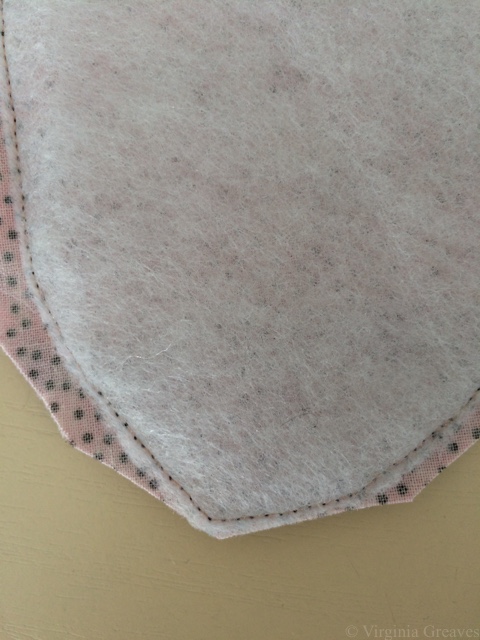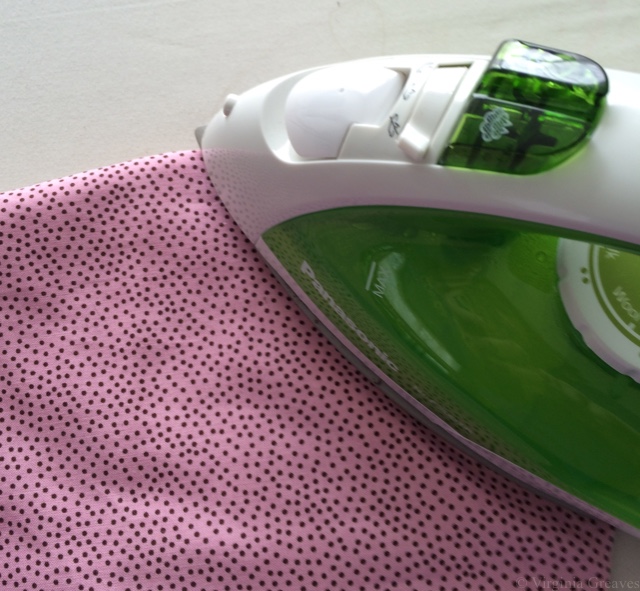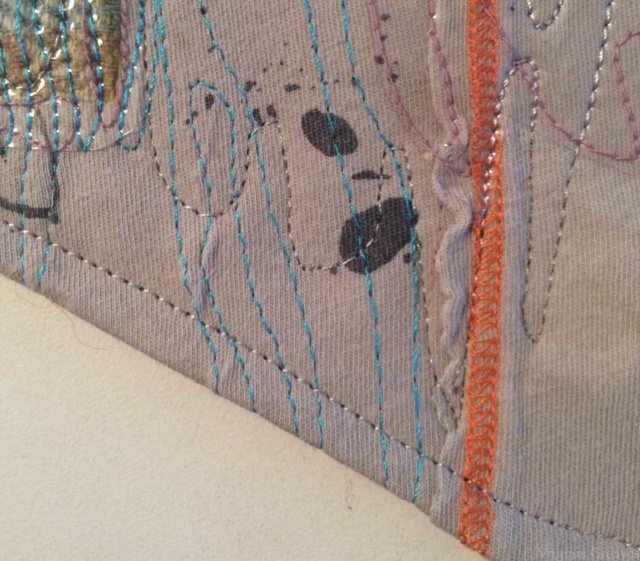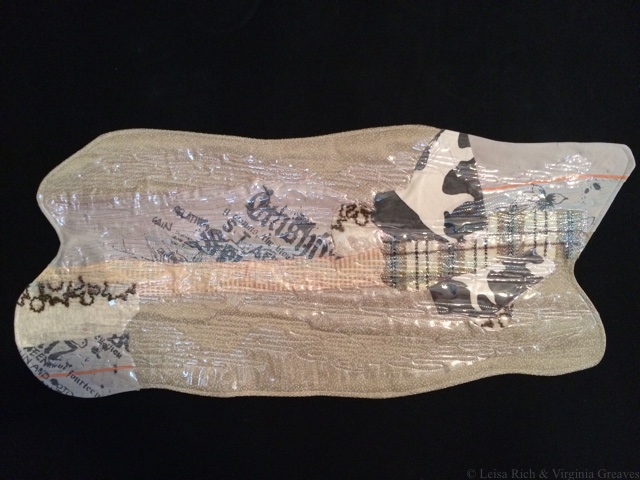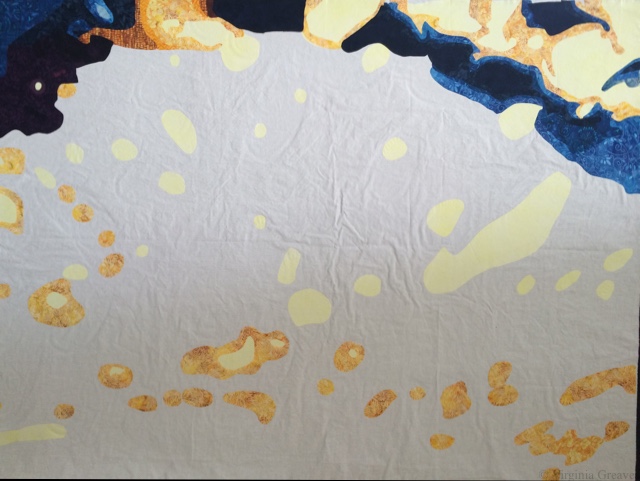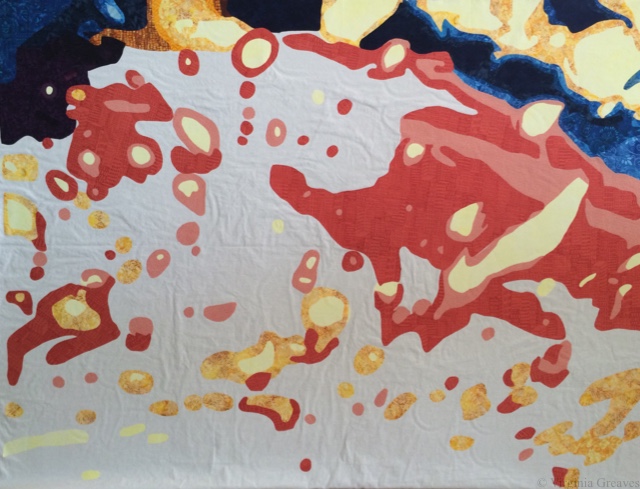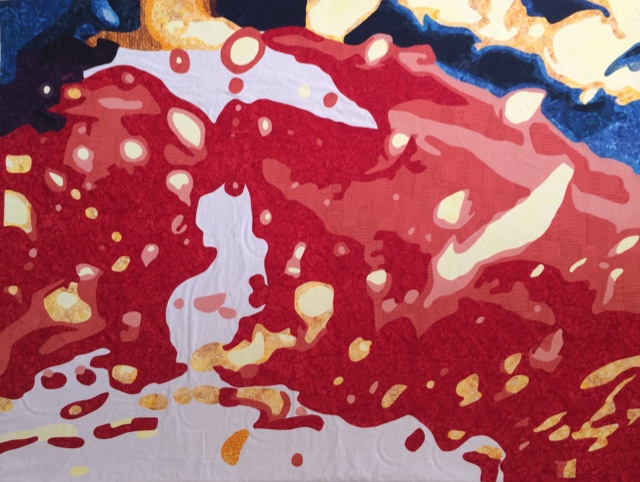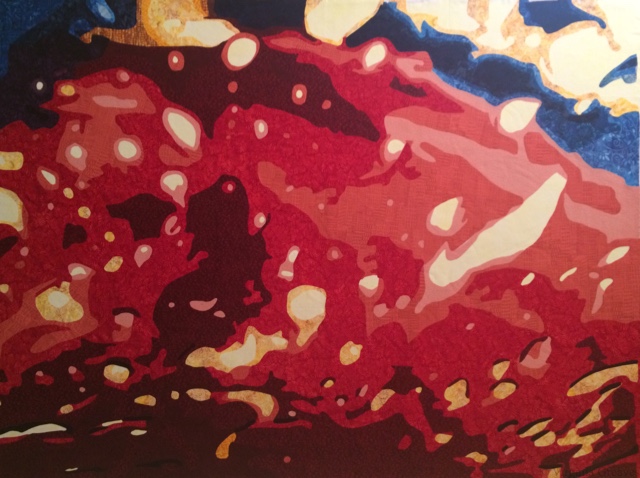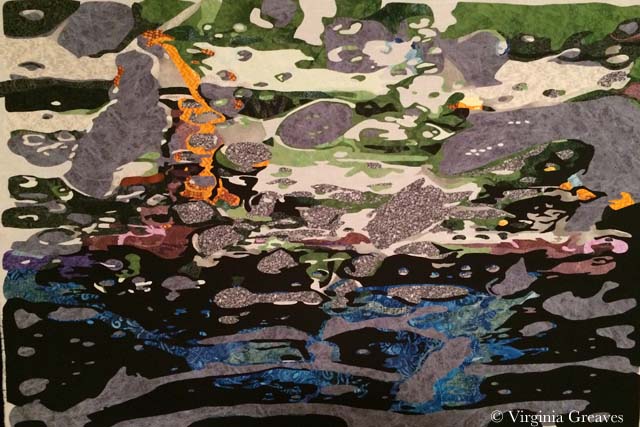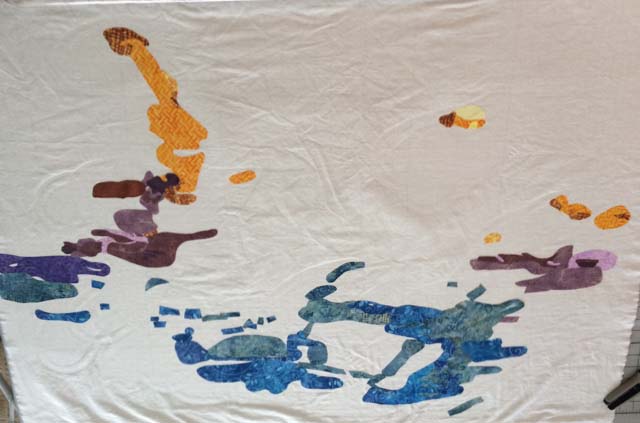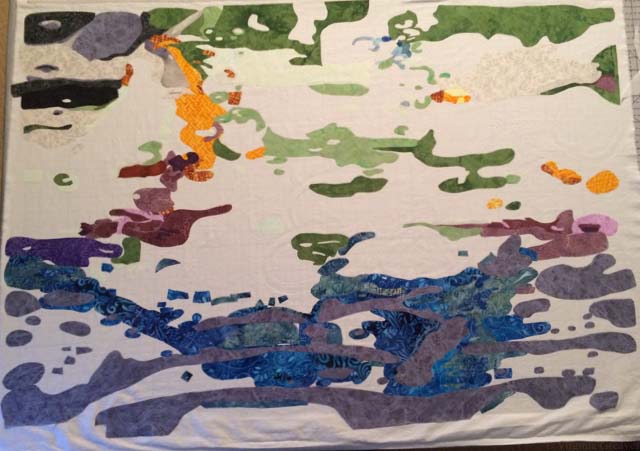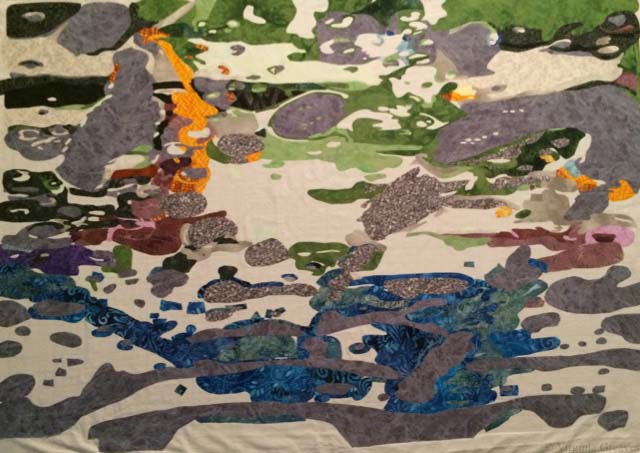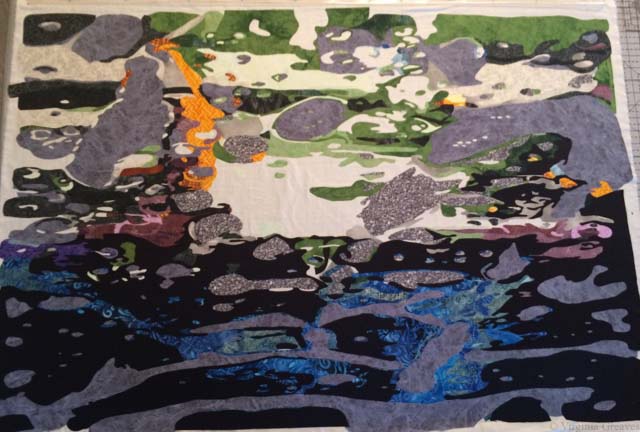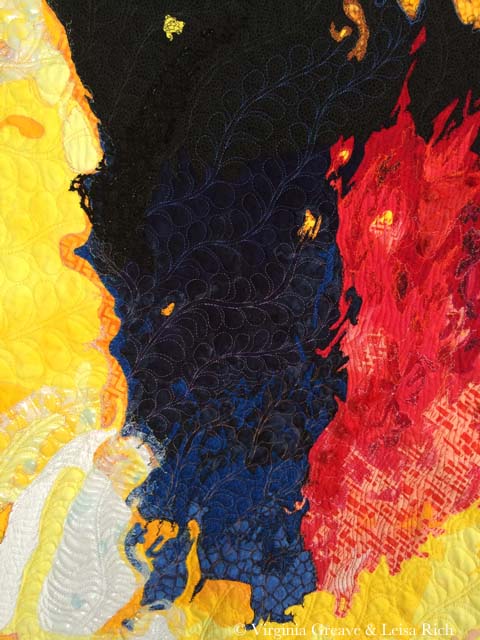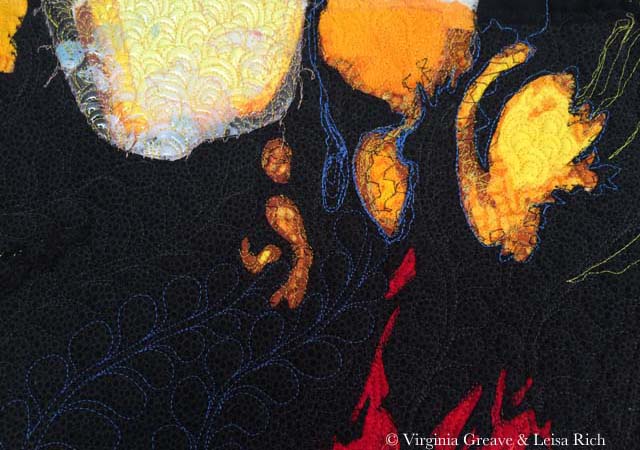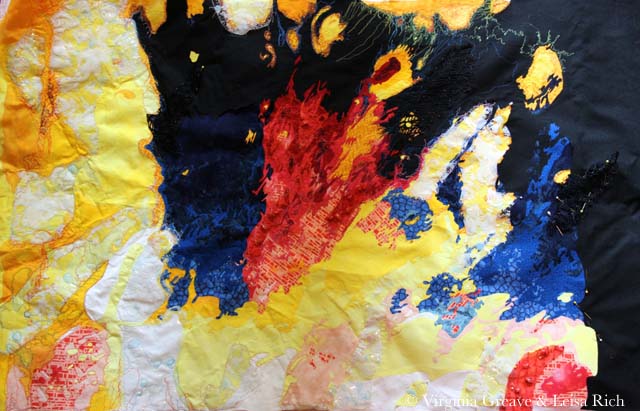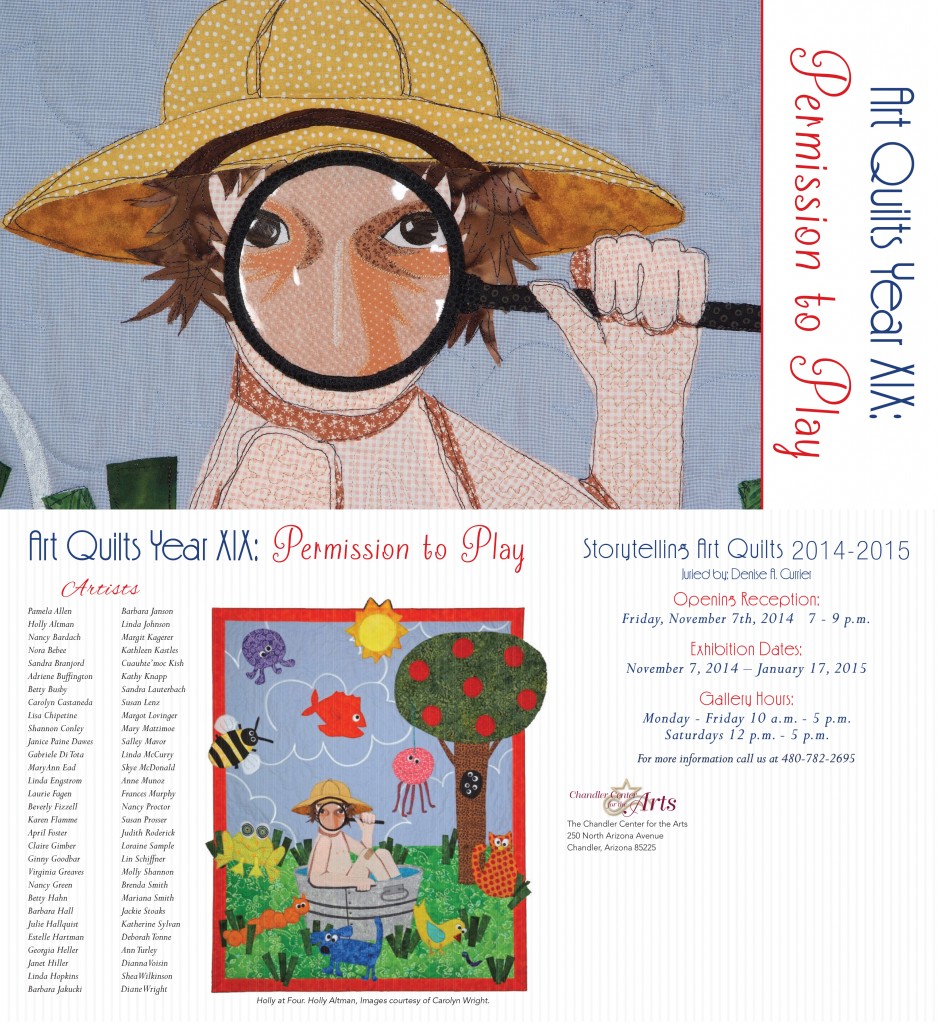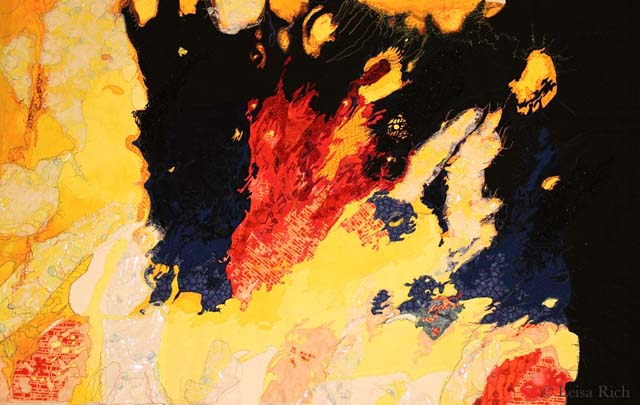Posts tagged abstract

Special Finish for Irregular Shapes
0I met with Leisa last week about finishing Abstract #4, and she wanted it to have completely irregular edges. It sounds completely simple, but if you know anything about binding a quilt, it’s really not. I considered a facing, and I’ve begun to really like the look of a faced quilt from the front since there is no distraction of any binding, but facing it would still mean having to join strips at some point, and if none of the points were square, joining them on the bias would be a nightmare.
I briefly considered a bias binding.
After discussion of this dilemma, Leisa suggested that I finish it with a false back. I would have to add some more quilting afterwards, but the end result would be a faced irregular edge without worrying about binding or facing strips. It would be similar to what I’ve been doing on the free-form pieces, so I decided to give it a try on a larger scale. The only difference is that this piece is all ready quilted. I would have to add some more quilting at the end.
First thing, and sadly I don’t have a picture of this, I took a few markers and drew curves on the quilt to indicate where I wanted the boundaries to be. Then I took a top black thread and a bright yellow bobbin thread (that I would be able to easily follow on the black & white fabric on the currently quilted back) — and I sewed on the drawn line. I would use this as a guide later.
I took my false backing fabric and stretched it flat on a table with the front side up.
I then layered the quilt face side down on top of the false back — right sides facing each other — and then pinned them. I pulled a little on the fabric as I went to make it as taut as possible.
When I flipped it over, it was taut enough I think I could have flipped a penny on it.
I flipped it back over so that the false back was facing down and the quilted back was facing me — and stitched a line over the yellow guide line I had sewn earlier. I did find a section that was relatively straight, about a hand’s width, and left that section un-sewn so I could use that space to turn it right-side out later.
Using sharp scissors, I cut a 1/4″ from the sewn line to remove excess fabric.
I clipped my inside corners to the sewn line (but not through), and I shaved some of the seam allowance from the outside corners.
And then all that was left was to turn it right side out.
Once turned right side out, I carefully poked out the outside corners and smoothed the edges. It still looks like a pillowcase at this point.
But I turned it over and from the back, I steamed the edges into submission.
I did press down the seam allowances in the section that was un-sewn and pinned them. I’ve learned from experience that it’s a good idea at this point to check that there’s not excess fabric across the middle, and if there is, smooth it towards this un-sewn section, re-fold the seam allowance to pull in that excess fabric, and re-pin. The goal is to make the back as taut as possible.
When I was done, I picked a neutral thread, something that I thought would blend well across all of the fabrics on the front (for me, a charcoal), and topstitched the edge about a quarter inch from the edge.
The result is a very flat piece with irregular edges. I did go back and quilt on it for a couple more hours, ditch stitching around the major shapes, and I liked the added dimension that that gave the piece. In the end, I didn’t save any time from adding a binding, but my fingers were happy to not do the hand sewing, and the result is a very well done irregular faced edge. (I did have to hand sew the sleeve to the back at the end.)
I could have, by the way, done this in the beginning with my first back before I started quilting, but given how tightly I quilt my pieces and how large this piece is, I felt that there would be tucks on the back. When you quilt tightly across the grain, fabric stretches, and it’s nice to be able to smooth that out to the ends and off the edges if you need to. With this technique, I wouldn’t have had that opportunity — the pulled fabric would have been trapped at the faced edge. It would have saved me the second quilting time though. Something to consider next time.
But now she’s done. She’ll debut in our two-person show at The Abernathy Art Center in Sandy Springs, GA, in September/October.
I have a page for Abstract #4 here — but the final pictures won’t be debuted on the website until after opening night in the gallery.

Construction of Free Floating Abstract Pieces
1I haven’t written much about the free floating piece that will cover one long wall of the gallery in our two-person show, partly because it has been an exercise in experimentation to see what would work. I think I’ve gotten better as I’ve gone along and thought that I would share some of my wisdom.
In these examples, Leisa has constructed the main pieces — the fronts. She has used either the skeleton or the brown polka dot fabric as a stabilizer (since she has all ready embroidered them at this point). The pink fabric will be the actual backing of each piece.
Here, I have placed the actual piece face down on the pink backing fabric (right sides together) — and I have taped down the backing fabric to keep it flat. I have merely rough cut it so that it is big enough for each particular piece. I pinned them together, checked the back to make sure it was smooth (making adjustments as needed), and then sewed them together at the 1/4″ mark with a basting stitch — leaving, of course, an unstitched area about 6″ long through which I can turn (or pillowcase) this later. Remember, I’ve sewn right sides together, so at this point, I have wrong sides facing out. I will later turn them right sides out. (Backstitch a few times at the beginning and ending — there’s a lot of tugging on these to turn them right sides out.)
When I first started doing these, I did not do this basting step. I merely layered the batting (2 layers of fluffy polyester), the backing, and the front. I didn’t worry too much because of the thickness of the batting. It was my goal to lightly quilt them so that each piece would be more sculptural than a flat quilt.
The economics finally won out, however, and at some point, we realized that there were so many of these, we would have to be content with one layer of batting. Well, that changes the game. At that point, I have to worry about puckering on the back.
After basting, I cut the pink backing even with the front.
Then I rough cut out a piece of batting, placing it underneath the backing, and pin all of those layers together.
I sewed a smaller stitch length on top of the previous one. In this example, the basting is white thread, the tighter stitch is black thread. Again, I leave the opening for turning.
Afterward, cut the batting (only) as close to the stitched line as possible. Also cut the batting from the section where there is no stitching, guess-timating where the stitching would be.
Before turning these right side out, you need to clip corners. (And yes, I forgot a few times and had to turn them back to clip them.) Clip the inside corners as close to the stitching as possible without clipping the stitching line. No worries if you do — just re-sew the line where you cut it before continuing.
On the outside corners, trim all of the layers close to the the stitches. You want to minimize the bulk in the corners so they will lay as flat as possible after turning.
At this point, you turn the piece right sides out. On one of these, since I have three layers, I turned it right sides with batting on the outside. I was on the phone and not thinking about what I was doing. Turn it so the backing and the front are facing right sides out.
And then, another step I added after several problems, the end result is much better if you take the time to steam the edges flat. Although the long edges are fairly tame swooping curves, I have some sharper shapes on the ends, and ironing them flat (from the back since I have some plastic pieces on the front) ensured that the back behaved.
Also iron down the unsewn edge through which you pulled the piece right sides out, folding along the seam allowance — being very careful to make sure that the end result pulls taut from the opposite corner on the back. If you don’t check, you will invariably end up with a little extra on the back. Pin that section to keep it in place (pin on the front).
Then flip back to the front side and sew a topstitch 1/4″ from the edge all the way around. This will also close the opening that we used for turning.
Then quilt. Although I generally quilt my pieces to death, these are meant to be more sculptural. That’s partly why we chose to use the polyester instead of the flatter cotton batting. I quilted them in sections so that some areas rise up.
This is one of the turned pieces.
The intention is to hang them on the wall independently, meaning that its presentation will be specific to the individual exhibition.
I toyed with the idea of using this same technique on abstract #4 — which is sitting on my design wall, ready to be quilted — since we’ve discussed making its edges irregular as well. The abstract wall pieces are small and I could get away without pin basting them. However, turning abstract #4 would require basting — and I can’t pin baste many of these because of the added plastics. I also know that intense quilting stretches the fabric, and not having a place for it to go could be problematic.
After research, I’ve decided that I will spray baste it, as I’ve done several of the others, and then after quilting, I’ll add large strips to the front which I’ll use as facing and turn to the back. Of course, I will then have to hand sew the facing down on the back, and we know I don’t love hand sewing — but I think it’s the best solution. I’ll add a sleeve after the facing is done.
Where there’s a will, there’s a way.

Abstract #5 Comes Together
0All of my studio time nowadays is dedicated to completing the projects for the two-person show I’m collaborating on with Leisa Rich to be debuted in October. Last week, while she was working on #4, I drafted #5 and started cutting it out.
Leisa asked me to go big on this one — so that is what I did. I went to the limits of what I could currently handle in my studio for this kind of project — 48″ x 60″. I had to have a surface large enough to fuse the shapes onto my canvas. Since my table wasn’t large enough, I ended up laying one of my design walls flat on the floor — it was exactly 48″ wide.
And for the pattern, for the first time in years, I used the services of a blueprint company and a vector program. My copy of CorelDraw was woefully out of date, and I don’t have a PC anymore, so I ended up purchasing iDraw which worked perfectly for my purposes. (Even after 15 or so years, my Wacom Graphire 4 tablet continues to be a workhorse for me.) I created the pattern and emailed it to the local shop. I did spend some time talking to them about what I wanted though because a print of this size can cost upwards of $80. I had it printed out on inexpensive paper on their 36″ wide printer and then taped the two pieces together (the final cost was under $10).
I also had to buy some rather large pieces of red fabric for this. I didn’t have anything in my stash nearly large enough.
Here you see it with all the yellows, blues, and dark purples.
And here you see the beginnings of the red.
Lots and lots of red. For this particular value, I had to buy 2 yards, and the largest piece still had to be spliced in one place because it was wider than 42″ (the width of the fabric).
And this is the final piece. I don’t know that my iPhone did the best job in the world, but it’s fine for an in-process shot. I think that this one is the most evocative of the car wash theme that we’ve done so far.
To be honest, I was surprised at the huge leap between value 4 and 5 — and that 6 didn’t stand out very well against value 5– but after cutting out almost 2 yards of value 5, I wasn’t willing to start over. It still accomplishes what I wanted it to. There is a lot of room for Leisa to go wild on the embroidery — can’t wait to see what she does with this one.
The last time we met, she gave me some more pieces to work on for the large wall piece, and I still have #4 to quilt. Lots to do.

Art, Work, & Life
0I didn’t post on my blog last week. There was a tide of work and life that consumed me and overtook my time. I stole some hours here and there, but I didn’t meet my weekly art goals.
I think everyone struggles with balance. I have work that helps pay the bills, I have a family to take care of, and I have my art that I need — just for me. All three constantly pulling.
I had recently finished cutting out and fusing the 4th abstract piece in the series I’m collaborating on with Leisa Rich. This is what it looked like when I gave it to her.
And she spent a couple of weeks on it. There is a tremendous amount of embroidery stitching on it now — and these very cool things cut from canvas that she printed images on through her printer (have to make a note to try that) as well as vinyl (some in blue!). There is also this cool fabric that’s blue and orange that adds the hot colors more along the bottom.
I love it!
Leisa suggested that I finish this as an irregular shape — not a rectangle. The technical person in me started immediately thinking about how I could do that. We’re also doing some free-form shapes and I pillowcase them — which means I sew the backing onto the front (right sides together) with an opening on the side — and then turn it right side out and topstitch the sides down. That would work here — but I wouldn’t want the edge topstitched on such a large piece. I would just need to hold down that seam while I quilt it — so I’m thinking maybe a water soluble thread. However, if I do this, I can’t quilt it heavily — there would be no place for any stretching to go.
I’ll think on that for a while. For now, I’m still cutting and fusing #5. I should have been done by now, but life keeps getting in the way. Hopefully, I can make a lot more progress this week.
I forgot to take pics of the free floating pieces. These are smaller pieces that Leisa is constructing — and then I’m quilting them and doing the finishing work (or rather in this case, I’m pillowcasing and topstitching the edges of them, which is the finishing, and then quilting them.) Each of these will hang independently on a very large wall and can be moved around depending on the exhibit space. They are less like quilts and are more sculptural in design.
We’re making great progress. I have at least 3 more pieces to plan, but we have until October when the show opens here in Atlanta.

Studio Frenzy
0Last week, I finished cutting the 4th abstract in the Car Wash series that I’m working on with Leisa Rich.
Like my other pieces, I approached it with the intent of cutting it out in color order starting with the yellows, then the purples, then the blues — but as I went on, the entire thing became unwieldy. Breaking it down into meaningful pieces became really hard. I became best friends with my colored highlighters — and I bought more of them. I rued the day that I had drafted this thing. I think I may have pulled some hair out.
I ended up with all of my fabrics on the cutting board and the master pattern on top of the piece I was constructing.
This was my first picture.
I started working on the blues at the bottom, then adding in the grays.
Then I started working on the top but was coming to the realization that the only way I could approach this monster was to finish whole sections as I came to them.
This is just insanity. I did realize that I was almost out of that medium gray and I was going to need more. I was very pragmatic about it, though. I put all of the gray that I did have along the outer edges. Then I planned a search mission to the fabric store and luckily found something in the same color and value. It has a lot more texture, but I think that that’s fine.
Here, I can see the light at the end of the tunnel. Literally, everything is done but the part in the very middle. At this point, I highlighted that section in the middle on my pattern so I’d know where I was. I kept getting lost.
And here it is before I gave it to Leisa — a quick shot on my wall before I whisked it away. She is embroidering it. So many edges.
On my new time keeping app, I can easily see how much time I’ve spent doing something. I spent 39 1/2 hours cutting this out. Holy cow.
So my next piece is going to be much simpler. It has to be. I have at least 4 more large pieces to do for the show and I want to have them completed by the end of May.
Since I handed this last abstract piece off to Leisa, I’ve been working on the abstract piece that will cover the largest wall in the gallery. It will be made up of a lot of smaller pieces that will be hung individually. Leisa is making the tops of these pieces — and she gave me a bunch to work on. I pillowcase turned them — no easy feat — topstitched them, and am now adding some quilting. They’re meant to be very textural on the wall so they aren’t heavy with quilting. I’ll share some pics later.
I also wanted to share this picture of my daughter in the Dominican Republic. She went after Christmas on a mission trip with her school and her father.
I let her take my camera — my DSLR Canon T3i. I was looking forward to seeing all of the pictures of the DR, but alas, the only pictures I will see are the ones they took with their cell phones. This is the last known sighting of my camera — it was stolen at the airport on her return trip home.
It made me very sad, but I have all ready replaced it. The camera body came last week — and I’m waiting on the lens. It should be here today or tomorrow. Instead of the 18-55mm kit lens, this time I opted for the “nifty fifty” — the prime 50mm lens. It has no image stabilization or zoom — but it’s “faster glass” with an f-stop of 1.8 compare to the f-stop of 3.5-5.6 on the kit lens. It’s a less expensive lens, but I’m told that it’s a far superior lens. Can’t wait for it to get here!

More Pics Please!
0A friend told me that it was hard to see what I had done on the piece from my last blog post so I have posted some more detail pics. I hope this makes it easier to see the quilting.

Quilting as Another Dimension
1Yesterday I finally finished quilting the 3rd abstract piece that I’ve been working on collaboratively with Leisa Rich. I have to admit that I let my mind run away with this one.
This is a pic that Leisa took of it after she had added embroidery.
And this is the same piece after I have quilted it.
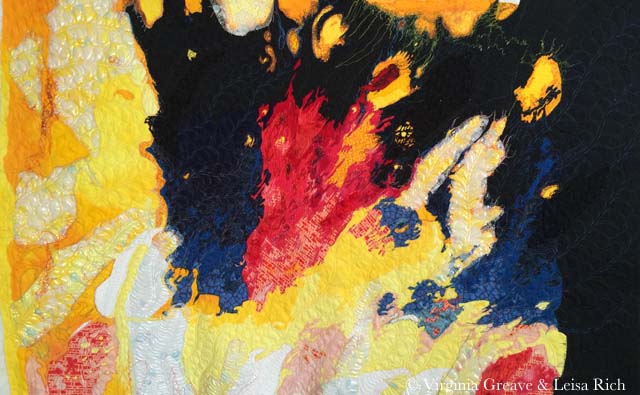
I started with free motion quilted feathers — in metallic thread. CRAZY if you’ve ever sewn with metallic copper thread — but I had the wind at my back that day and it flowed like water onto the surface of the piece. I graduated through copper, purple, blue, and then a gray for the deepest part of the black fabric. I then moved over to the red and brought a flame stitch out of my bag of tricks. Then I moved down into the yellows and whites. I did change to more of a wavy frond for the white — I liked the difference in texture — and some of the yellow blobs were awarded with scallops. I did revisit the copper thread on the lighter blue fabric over on the right hand side — but I was not lucky on those days and struggled with a lot of broken thread. I moved back into blue thread as soon as the piece was ready for a change.
I love free motion quilting on my Janome. Even sewing on the plastic overlay didn’t cause many problems. My Viking would have given me fits.
I hope Leisa forgives me for putting traditional feathers all over it. It called out for that organic feeling. I’ve never used so many free flowing feathers on a piece in my life. It felt good to step out of contour quilting.
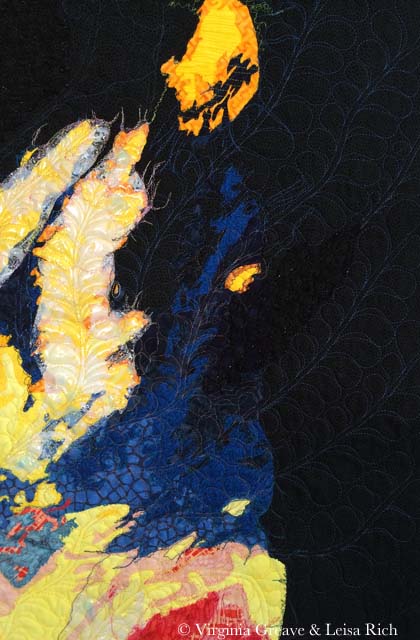 I am giving this back to Leisa next week — I think she’s planning some hand embellishment.
I am giving this back to Leisa next week — I think she’s planning some hand embellishment.
We have a curator that approached a local Atlanta gallery about having a two person show of our work — and it looks like we have reached an agreement and the show will go on in late 2015. Time to get busy — I have a lot to do to get ready!

Opportunities
1I have been quilting the third abstract in the car wash series — having fun with it. I eschewed my usual contour quilting for feathers, flames, & fronds. I love the way it’s turning out. I’m also using the thread to pull colors across applique boundaries — and playing with thread choices. I even coaxed a metallic thread to free motion into feathers.
But I only worked in the studio a couple of days this week. I have a friend that’s been giving me scoping work. I hope to get back in the studio tomorrow.
I would like to say that I’ve been working on another portrait for the National Portrait Gallery competition — but inspiration hasn’t struck. Right now I am in the flow with abstract and I have not been successful in changing my direction.
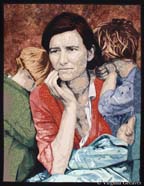 If you read my Facebook Page, you saw me hyperventilating when I was notified that I won a ribbon in Houston again this year. It’s such a huge honor & completely unexpected. I won’t know till the ceremony at the end of October what the prize is exactly. I’m lucky that I’ll get to go to Houston again this year and actually stand in the Winners Circle.
If you read my Facebook Page, you saw me hyperventilating when I was notified that I won a ribbon in Houston again this year. It’s such a huge honor & completely unexpected. I won’t know till the ceremony at the end of October what the prize is exactly. I’m lucky that I’ll get to go to Houston again this year and actually stand in the Winners Circle.
I may even tweet the whole event like I did last year. It was such an exciting time and I loved sharing it.
For those interested in attending, Preview Night for IQF/Houston is October 30. The show is at the George R. Brown Convention Center and runs through November 2.
I did, in fact, come home after winning a ribbon with Lincoln last year and decided — after making animal portraits for a year — that I would make a person portrait again. Worry was the piece that I made from that decision.
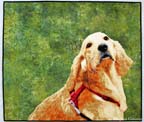 I also found at that Golden Moment was accepted into Art Quilts XIX: Permission to Play. This exhibit is at the Chandler Center for the Arts in Chandler, AZ and will show November 7, 2014 – January 17, 2015.
I also found at that Golden Moment was accepted into Art Quilts XIX: Permission to Play. This exhibit is at the Chandler Center for the Arts in Chandler, AZ and will show November 7, 2014 – January 17, 2015.

New Solutions
0Last week, I completed the 1st and 2nd pieces in the collaborative series. I did the 2nd one first — the larger one — and all of the binding was done by hand. The 1st one — the smaller one — I couldn’t bear to hand stitch the binding. I had too many holes in my hands. I just couldn’t do — so I did something I’ve only done once before. I machine stitched the binding.
I drew out the outline of the final boundaries on the top. Then I stitched on top of that outline using a yellow bobbin. Then I turned it over and used the yellow line to show me where to machine apply the binding. Once it was on (and the top edge of the sleeve), I cut off the excess.
There is a lot of plastic on the top of this one so I had to be very careful with this next step. I love using Sharon Schamber’s trick to hold the binding in place with water soluble clear Elmer’s glue that has been pressed with an iron — but doing this meant folding the binding to the top and pressing right next to the plastic without melting it with my iron. It had to be hot enough to engage the glue to hold — but not hot enough to melt the plastic underneath. I was “pressing” my luck but I did it anyway and it worked well enough. I then used a machine blanket stitch to attach the binding to the front.
I’ve been surprised over the years that — the only other quilt I’ve done this with — I have hanging in my living room and I truly forget that the binding was attached differently. Looking at it very closely, I prefer it the other way. If the final stitches are on the back, any irregularities are on the back — but my hands had to have some time to heal. I think it turned out fine. I still had to hand stitch the sides and bottom of the sleeve and the corners of the quilt — but there wasn’t a lot of that.
My typical process after finishing a piece is to block it, photograph it, and then post a new page for it on my website. Leisa and I both agreed not to completely block these pieces — although I did spray the binding with water and, on the small one, I pinned it to the ironing board and soaked the binding only in an effort to make the piece hang straight.
I photographed the 2nd one with no issues. The 1st one cannot be photographed using my traditional methods — the plastic across the front on top of the black causes too big of a glare. After spending time reading about this, I think I’m going to have to built a light diffusion box just for the purposes of getting a good picture — so there is a future project.
Leisa has asked that we not debut the final pieces until they are exhibited all together in (hopefully) late 2015. Therefore I will post pages for them without final pictures — only a notice of exhibition. This was a hard decision for me but I agree that seeing all of the pieces together creates an impact that would be diminished by individual publication.
I have been thinking about a portrait for competition — what needs to be my next piece — but I’m still in the idea stage so I started prepping #3 for quilting yesterday. Like #1, it has plastic on it — so it can’t be pin basted — my usual method. It would have to be spray basted — but it’s quite a bit larger than #1 so I jumped on the internet for some help and came up with the following plan.
First, I laid down a sheet on the wooden floor in my kitchen. (Yes I know it’s hideous — it was bought years ago for one of my girls. Makes it perfect for this.) I taped down the edges. The intent is for this to catch all of the overspray. When I’m done, I can just throw it in the laundry.
Then I tape the backing fabric face down onto the sheet.
And then I lay the batting on top of the backing.
I fold half of it back . . .
and I grab this can of 505 Spray and spray the BATTING that’s been folded back. I then fold it back onto the backing making sure that it’s smooth. If there is a wrinkle, I can lift it, move it, and then press it back together. Then I do the same thing with the other side. I fold the batting over at the halfway mark, spray it, and then smooth it back onto the backing fabric.
Once that’s done, I do the exact same thing with the top — except I still spray the BATTING.
It took me half an hour to do this, and at the end, my fingers didn’t hurt. I was at the end of a can and it started spraying out white goo — which thankfully didn’t transfer to the quilt. It just stuck to the can. I luckily had another full can to finish the job.
I should consider doing it this way more often. Even better, I realized this morning that I can draw out some intricate shapes on the top this morning without worrying about pins getting in my way. I know you’re supposed to do all of your drawing (if you’re going to do that) before you baste it, but my process is more organic. I add to the piece what it needs as I go along.

Leisa’s Turn with Abstract #3
0Leisa and I are having a such an exciting time with this series. It is so much fun to see what the other is going to do with the work. This is the 3rd one that we’ve done and we’re already planning #4 and #5.
I was wrong — this is not the one Leisa plans to cut into strips. In fact, she cut off all the extra yellow and black that I had added at the top and bottom and returned it to its horizontal orientation. I just chuckled. I liked it better that way too but it was her prerogative.
She free motion embroidered it like crazy, added black lace, painted it, added vinyl, and painted some of the vinyl (on the inward facing side) with nail polish. It gives it the coolest effect. (I’ll have to be careful about quilting those sections lightly though. I’m a little worried if you can needle through nail polish.)
And this is a detail shot — you can see the wandering embroidery lines a little bit better here.
It’s interesting to see the unintended forms that come out of this process. I love where this one is going. I’m going to quilt it and then let Leisa have another crack at it — she is thinking about adding handwork after the quilting.
I have finished the binding on #2 — and I’m almost done with adding the sleeve. I do think I’ll have to add another one though. It’s not straight across at the top so figuring out how to sleeve this one has been a challenge. I added a short sleeve at the very top where it is straight — I think I’ll have to add another one lower down on the other side. I couldn’t work it into the binding edge thought because it isn’t straight.
And then I need to bind and sleeve #1, the first small one that we did. I’m having to use different techniques on these. For instance, I couldn’t pin baste #1 because of the vinyl — I had to spray baste. I’ll have to do the same with #3. #1 also has a lot of vinyl on it around the edges — so it occurs to me that can’t use my usual water soluble glue trick to help me bind the edges (which thankfully are at least straight on this one).
And because of this issue, I realized that I probably shouldn’t use my usual blocking technique on these — particularly the ones with vinyl. If I soak them in water, the vinyl may inhibit evaporation and could lead to molding — a distinct possibility as I live in the Deep South — so I’m going to forego that as well. I haven’t had a waviness problem on any of them — yet — but if it becomes an issue, I’ll block them with spritzes of water — not a full soaking.
I need to make myself stop. It’s September and I would like to have a piece to enter in the Outwin Boochever Portrait Competition sponsored by the National Portrait Gallery. I need to start photographing inspiration for that one. I entered a few years ago and wasn’t juried in so I just assumed that it was a bias against alternative mediums. Completely untrue. Be careful not to create obstacles for yourself that don’t exist. Last year, the People’s Choice award winner was a sculpture made from rice, rice noodles, and glue by Saeri Kiritani — and there was a fiber finalist — Lia Cook. I can’t be accepted if I don’t enter. You can see last year’s winners here.
